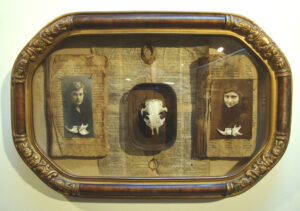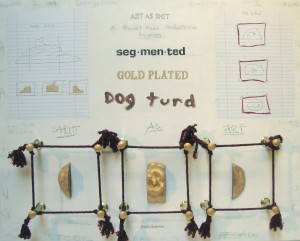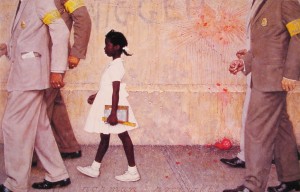Posted in
Art and Criticism on
July 19, 2013 – 9:03 pm
A few years back I was asked by a NM publication: Who were the most important New Mexican artists of the last 100 years? I ran across the list today and thought I’d share.
My first artist of importance isn’t an individual at all:
1. The Taos Society of Artists was formed in 1915-
They were significant because they were the first formally trained artists to establish themselves in NM working in the western (European) art tradition.
Although dismissed by many as mid-level academic painters (I obviously am not among them) these artists established the first foothold for artists in our state (and were quite the Bohemians in their day). Without them there is no art colony at Taos or Santa Fe, no Museum of Fine Arts, and no art market. These artists promoted the American West and brought our culture, landscape, and lore to the greater public.
2.Andrew Dasburg-
Dasburg brought Modernism to NM and made us a major center of Modernism in the Western Hemisphere (others being New York and San Francisco).
He literally opened the door for modern art in NM.
3. Dennis Hopper-
Hopper brought the counter-culture revolution to NM and NM to the US.
He started an influx of film-makers, artists, writers, etc. to NM that continues to shape our artistic tradition. Larry Bell, Ken Price, Ron Davis, and several others brought Minimalism from the west coast.
4. Fritz Scholder-
Scholder helped usher Native American Visual Arts into the modern era.
His influence continues through the generations of students he taught at the IAIA…and the subsequent generations that they influenced.
5. Georgia O’Keefe-
She is NM…difficult, spiritual, and austere.
O’Keefe continues to be the artist most associated with the Zen of the American West.
Posted in
Rants and Raves on
May 7, 2012 – 1:11 pm
Many of the conversations in my studio recently have dealt with the concept and definition of style. I find that artists are particularly interested in exactly “how” a particular image has been created. I have the teaching gene and have always been particularly open with what media, technique, and processes I use. In some ways this seems to be to my detriment…as I see more than a few knock-offs of what I’ve managed to create on my own. It’s puzzling to me that any mature artist would chose to mimic a body of work they admire. However, I do think that using others work to inform your own and building a foundation for that “and now for something completely different” creation is essential to growth.
Style has largely become something that one appropriates in our society. Style used to be what defined an individual…now it is available at the local shopping mall. Style is now a commodity that fashion designers and celebrities create…and we buy. What had always set visual artists apart was their abhorrent reaction to obvious formulations to “challenge” the status-quo. In the present era it seems the vogue to bow to the vagaries of what is commonly termed as “The Market”. Gone is the circa that required artists to be anything other than clever. A dead shark or a decaying carcass do summon up a few questions, but where’s the craft of it all? Style needs to be something that grows out of years of sifting through the center of one’s existential being. What am I attuned to? Where do my talents lie? What directions can I pursue that leave me the most liberty for creative exploration and the potential of a cohesive body of work? The co-modification of art has been both it’s bane and bacchanalian since man started taking a charred stick out of the fire and asserting his particular rift on the world he lived in. What seems to be waning now is the ability of artists to follow a path that is new or divergent from their previous trajectory. Concerns in the financial and critical realms tend to be decidedly non-nurturing and Darwinian in their nature. Style is both a unique voice gained through decades of exploration and a repetitive motif of identification. Whether the artist is defined by his work, the work by the artist, or a conglomeration of the two…style should always be a genuine representation of what they actually wanted to say. ..otherwise it misses the mark.
Posted in
Art and Criticism on
April 2, 2012 – 7:18 pm

This recent body of work is an attempt to relate on a visceral level the commonality of our experience with being and the knowledge of someday not being.
My interest in nostalgic items has caused many individuals to bring me old books of photos. This phenomenon combined with my wife’s recent interest in genealogy brought about my experimentation with this subject matter. Through research on genealogical websites I have been able to return some of these family heirlooms to their rightful owners. I also discovered that the majority of these family albums come my way because the family line has died out and there are no descendants. We kid ourselves that our existence (though precious) will be remembered long after we’re gone. The persons in these photographs all lived less than 100 years ago…no one is left to remember them.
The sum result of this knowledge is a bit daunting, but it makes us realize what is truly important. The relationships we have, the experiences we are fortunate enough to endure make this whole journey worth living. Our interaction with situations, individuals, and our own experiences makes for a powerful dialogue when we ponder the void. It is said that no one gets out of life alive. This statement may be true, but it is also what helps us all to have that common bond running through humanity.
Our species knowledge of its’ eventual fate sets the stage for musing about the ephemeral nature of existence. No matter what separates us (language, culture, or the period in which we exist) we all relate to our mortality. This knowledge and the use of relatable objects help to inform our reactions with this body of work. A bit of humor here, a touch of nostalgia there, and we are able to easily decipher what makes us human.
While it is important to appeal in a more universal nature it is also important to deconstruct why something is universal. Relationships, language, and our cultural moorings all make for an in-depth dialogue on what it means to exist as a sentient and cognizant entity. When you take a word back to its’ original source there is a moment of epiphany. You have used this element your entire life, but now you see it in a different light…with a new understanding. This act of consciously looking at a subject without preconceptions leads to a deeper examination of our world in general. A new comprehension is at play with reality and experience.
I have struggled mightily with the public perception of artists as personages who live outside of society. This view does have some merit…sometimes to properly observe what’s going one must be somewhat detached. Unfortunately the general public is downright hostile to much of the cutting-edge work being produced today. As artists, critics, and curators we bear some responsibility for this attitude. This is an era in which diamond-encrusted skulls, flaming dog turds, and dirty beds are presented as high-art…no wonder there is a disconnect with the general public.
I find there is a bit more genuine emotive value in trying to relate in new ways with more common objects that do not shock, insult, or demean an audience. This is one reason I view genres such as Outsider Art, Folk Art, and Art Brut as less pretentious and more inclusive. In order to reach your viewership you must create works that both speak to all levels and operate on multiple levels.
This all brings us to the actual usage of materials. In order to immediately careen the viewer into the position of a new perspective the materials must be used in a usual (yet accessible) manner. These unorthodox combinations of very mundane objects are a prominent trait of much of the Outsider Art I so admire. There can be a certain shrine-like quality to this genre of work. In some ways this is a remembrance of individuals that existed long before my time by my simply taking a totemic image of their existence and including it in my work. The graduation of a simple object by it’s inclusion in a rumination on mortality and shared experience.
This shared experience is what helps to transcend the media and speak of our common environment. The point of this is helping persons to relate in a positive fashion towards humanity. We are constantly overloaded in these times…bombarded by the crush of an ever-growing population. In many ways we insulate ourselves, but in some others we lose a bit of our humanity. These pieces are gentle reminders that what we share far outweighs those things that separate us. This view propionates the human race as a collective rather than an endless chain of competing individuals.
Posted in
Rants and Raves on
December 20, 2011 – 11:36 pm
This is a favorite excerpt from Robert Hughes’ most excellent “American Visions: The Epic History of Art in America”.
“The Taos of 1920 was not the Taos we have today. It had not yet become a high-sierra New Age theme park full of channelers, holistic healers, and matched blond lesbians in Jeep Cherokees.”
Not only does Hughes claim Edward Hopper as the greatest American artist, but he’s pretty spot on for his overview of modern Taos (and Sedona even more for that matter). His views of Mabel Dodge “…a mystagogue and an egotist, a sexual imperialist and much of the time an intolerable bitch…” are quite unflattering. BTW…Hughes should know a bit about being an egotist. Nonetheless, he has written my favorite treatise on American art.
Posted in
Rants and Raves on
November 15, 2011 – 8:02 pm

I have had quite a few people who were quite amused by my recent mixed media piece “How Clever (Hirst Meets Koons)”, but have done more than a bit of explaining the nuances of my title and it’s connection to the work. This work is a reaction to the type of oh-so-clever work being done by conceptual artists. Damien Hirst is the British artist who cut animals such as great white sharks and cows into segments and displays them in vitrines of formaldehyde. This accounts for the segmented part of my piece. Jeff Koons is an American artist who has others manufacture his work. One of Koons’ “artworks” is a 15′ Mickey Mouse that is gold-plated…thus the reference to gold-plating in my work.
I am not a Stuckist, but I do have quite a problem with the direction that a lot of conceptual art is presently moving towards. I enjoy blurring the lines and challenging the reining concept of what art should be…and yet it bothers me that these artists have no technical skill and are basically “taking-the-piss” out of the public at large. I do agree with the Stuckists on one thing…Turner is the only person who couldn’t win the Turner Prize in this current atmosphere. It would seem that being clever has overshadowed the ideal of craft and diligence on the part of the artist. It also is troublesome that dealers such as Charles Saatchi can manipulate the market and curators (see Nicholas Serota) to champion such shoddy work. It seems politics are alive and well in the art world of today. Lots and lots of “empty suits” out there.
3/ 10 /12
An update…Andres Serrano (muy infamoso for “Piss Christ”) had a show in NY w/ 4 x 8′ photos of various feces. I was not aware of this “prescient body of work”, but am not surprised I overlooked it’s intrusion into any serious discussion on aesthetics.
Posted in
Art and Criticism on
October 27, 2011 – 5:40 pm

Early in my arts “education” I ran upon the rather curious disdain by the intelligentsia for anything deemed “Illustrative”. While I somewhat understand this distinction…I am flustered by its’ decidedly negative connotation. I remember doing a paper on the most-excellent Mexican artist Jose Luis Cuevas, in which I referred to Cuevas as an illustrator. Of course the TA (teaching assistant) who graded my work was quick to point out that the artist in question “is not an illustrator”. I found this response rather pompous considering the context was in referring to Cuevas’ first introduction to a large audience … his illustrating a re-release of Kafka’s “Metamorphosis”. I (apparently mistakenly) have always considered visual artists who illustrate books to be illustrators…that may not be all that they are, but it is something that they have delved into (examples: Folon, Homer, Warhol).
I have always considered the moniker of illustrator to mean that we are dealing with someone who can actually draw…unlike many who graduated from the art departments at major universities during the 60’s/ 70’s. When I think of illustrative work I think of highly stylized works the likes of Leyendecker (who I love) or Nagel (whom I despise). We can see several examples of “fine artists” who have an extremely illustrative style…the photographer Herb Ritts comes to mind. [Ritts’ portraits of the celeb-of-the-day aren’t the clever analogies to the com modification of celebrities by Warhol, but the end result is the same for me…although Ritts subjects are quite vapid in comparison to Warhol’s.] There are also artists who primarily work as illustrators who seem to supersede the category itself…Ralph Steadman comes to my mind.
It seems that the distinction of degrees comes into play somewhere here. Norman Rockwell is definitely an illustrator, but images such as the civil rights piece “The Problem We All Live With” (above) certainly transcend the genre. I would say that Thomas Hart Benton‘s highly-stylized works are definitely illustrative, but they are categorized as fine art. Both of these artists delved into the social upheaval of their times and both have been poo-pooed for their decidedly regional and mundane subject matter. To the other extreme we have “artists” like Damien Hirst who (despite his efforts) can’t paint or draw…and Jeff Koons who has others “manufacture” his repulsively ugly works. Which are the real artists…and who are the posers?




